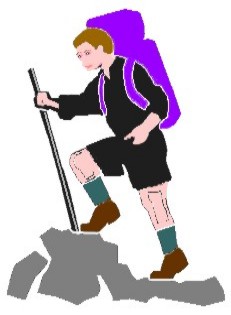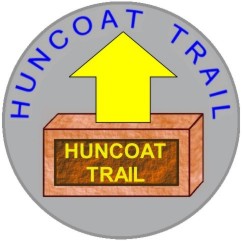 Site Map |
|
 |
| We now have all this country walking, rambling, hiking, trekking and Roaming going on. But just how did it start?
Well off course in the middle ages walking was the norm because it was the only means to get anywhere and as the land was ‘common’ folk were free to roam it and gather from it. A network of footpaths therefore existed.
Then came the enclosures and land acquisition into private ownership and walls and hedges began to be erected to mark boundaries, constrain livestock and prevent poaching. Many footpaths were closed and blocked off leading to disputes but the law usually favoured the land owners. Ordinary folk did not travel far from home anyway, they could not afford the time and effort and there were laws against vagrancy.
Wild places like inhospitable hills and mountains were regarded with awe and disdain, little beauty was discerned in them. Therefore, land and estate owners who could afford the luxury manicured their land into scenic parks. It was the Victorians and Poets who romanticised the wild places and converted folk into admiring bleak hills and grim mountains. Now they were beautiful and majestic!
It is important to realise that most of our countryside is not natural. It has been fashioned by the hand of man, clearing forests, grazing animals, growing crops and erecting walls and hedges. Even the famous landscape of places like Rannoch Moor were not always so stark. They may well have become desolated by countless years of sheep and deer grazing. Before ‘the clearances’ the moor was dotted with crofts but by 1837 to increase grouse numbers there had been intense culling of native wildlife.
Tensions about access to the countryside increased with the coming of industrialisation and railways when mill workers began to have enough money to travel about and visit places. In the 1820’s groups for the preservation of ancient footpaths were formed and as early as 1847 there were confrontations about access. The 6th Duke of Atholl stopped a party of botanists walking up the old drover’s road in Glen Tilt. An earlier duke had evicted a large number of residents from the glen to make way for sheep grazing and deer stalking.
By 1848 recreational walking had become an established tradition with highly organised rambling groups forming and guide books being published. However, access issues increased with further land grabs by the aristocracy and particularly bad examples by the Royal family of popularising the Highlands for hunting, shooting and fishing. Also water authorities evicted farmers and livestock from catchment valleys and banned walkers for fear of contamination.
In 1884 James Bryce MP attempted to bring in an ‘Access to Mountains’ Bill but this failed to get a ‘second reading’ and it took a further 50 years to make any kind of progress even though Britain’s first ever rambling federation ‘the West of Scotland Ramblers Alliance’ was formed in 1892.
In 1928 established walking groups began annual rallies at Winnats Pass to protest about lack of access to the local moors and by 1935 there could be as many as 3,000 walkers protesting. In 1929 Labour Prime Minister Ramsey MacDonald set up a parliamentary committee to consider the establishment of national parks. The National Council of Rambler’s Federations was founded in 1931 and renamed the Rambler’s Association in 1935.
Sunday 24th April 1932 (4 weeks after Easter) saw the mass trespass of around 500 onto Kinder Scout led by Benny Rothman. The moorland was owned by the Duke of Devonshire which he maintained as a preserve for hunting game and was strictly patrolled by gamekeepers. Ordinary towns-folk had no place there yet they wanted somewhere to escape from the smoke, grime and claustrophobia of the mills. The meeting place was advertised as Hayfield Recreation Ground but the police turned up in force to prevent this as it contravened a council by-law. The walkers gathered instead in a disused quarry. Once on the moor some of the walkers were confronted by gamekeepers with sticks and there was a bit of a fight although no one was seriously hurt. Despite using a legal footpath to return from Kinder Scout six men were arrested afterwards and jailed.
Protests like these eventually led to the establishment of an ‘Access to Mountains’ Act in 1939 but even that had a strong anti trespass provision built into it. It took the Second World War to change attitudes drastically and revive the idea of National Parks.
A journalist who reported on the Kinder Trespass was Tom Stephenson a rambler himself but less confrontational in his approach. Born in Chorley in 1893 he was a teenager when the family moved to Whalley. It was from here that he climbed Pendle for the first time and discovered a passion for rambling, particularly in the wild uncultivated places. He became editor of the Hiker and Camper magazine and his political interests brought him influential friends in the Labour Party. In 1935 he conceived a vision of a ‘long green trail’ stretching from the Peak District to the Cheviots.
After the war Stephenson became Honorary Secretary of the Ramblers’ Association and through his connections with the new Labour Government pressed for facilities for access to the wild uplands, drastic revision of footpath law, the creation of national parks and long distance footpaths. The ‘Access to the Countryside’ Act was passed in 1949 but it was not until 1965 that he stood proudly in Edale on the occasion of the Opening of the Pennine Way. This was Britain’s first long distance footpath and Stephenson went on to influence the formation of many other trails. Even in old age he was campaigning in the Forest of Bowland for freedom of access to the Duke of Westminster’s lands but he died in 1987.
Definitive Maps
How did footpaths and “public rights of way” come about?
Before the coming into force of the Highway Act 1835 there were no public rights of way which were not highways and all highways were considered to be maintainable by the 'inhabitants at large in the parish'. The Highway Act 1835 placed highways under the direction of parish surveyors, and allowed them to pay for the costs involved by rates levied on the occupiers of land.
The repair provisions in s 23 of the Highway Act 1835 did not apply to footpaths and bridleways because they did not fall within the definition of “highway”, which prior to 1835 specifically meant a vehicular and general purpose route. In practice maintenance was carried out by the County Councils in the rural districts and by the Borough and Urban District Councils in urban districts, although by 1947 a number of highway authorities had ceased to maintain footpaths and bridleways, invoking s 23 of the 1835 Act in their support.
In September 1947 the Report of the Special Committee on Footpaths and Access to the Countryside (Hobhouse Report) was published. It recommended that all rights of way should be surveyed and recorded on maps, the work to be the responsibility of county and county borough councils. The recommendation was put into effect through the enactment of sections 27-38 of the National Parks and Access to the Countryside Act 1949.
Under these provisions all county councils in England and Wales were given the duty of surveying and mapping all public rights of way in their area, classifying them as bridleways, footpaths or roads used as public paths (RUPPs). The survey had to be undertaken in three stages: draft, provisional and definitive. The showing of a path on the definitive map was conclusive evidence that it was a public right of way at the date the map was prepared. The survey was optional in London and in the county boroughs; county councils were also empowered to exclude built-up areas from the otherwise compulsory survey.
|
 |
 |
 |
 |
 |
 |
 |
 |
 |
 |
 |